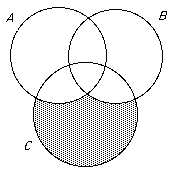10 t = 100 +10t/17 ⇒ 16t/17 = 10 ⇒ t = 170/16 or 10 5/8 seconds.
Generating the Geometric series gives:
10 + 10/17 +10/172 + 10/173 + ... and [recalling that the sum of a + ar + ar2 + ar3 + ... = a/(1 - r)] this sum is 10/(1 - 1/17) which is the same.
 (a) Look at the Venn diagram:
(a) Look at the Venn diagram:
Both sides of the identity are the shaded area.
(b) Take D to be the empty set and it is easy to see that the statement is then false.
(c) If (x, y) ∈ LHS then x ∈ A ∪ B and y ∈ A ∪ C and so (x ∈ A or x ∈ B) and (y ∈ A or y ∈ C). Looking at these four possibilities gives (x, y) ∈ A × A or (x, y) ∈ A × C or (x, y) ∈ B × A or (x, y) ∈ B × C and so LHS ⊆ RHS.
The proof that RHS ⊆ LHS is similar.
The second statement is false since there is no choice of y which will work for all x.
In the third statement we may take y = 0 and this choice will work for all values of z and so the statement is true.
If the statement ¬(∀x)P is true then (∀x)P is false and so there must be some x for which P is false. That is (∃x)(¬P).
Similarly, if ¬(∀x)P is false then (∀x)P is true and so there is no x for which ¬P is true. That is (∃x)(¬P) is false.
The proof that x - r and xr are irrational is similar.

The number x + y is not necessarily irrational. For example, x = -y = √2 gives a counterexample.
Similarly, taking x = y = √2 shows that x - y, xy and x/y may be rational. Of course, these combinations may be irrational for some values of x, y.

Take the point which divides the interval (r, s) in the ratio of 1 : √2. This is (√2 r + s)/(√2 + 1) and lies between r and s. It is a simple exercise to verify that if this were rational then √2 would be also.

If √(n + 4) + √(n - 4) is rational, then its square is rational ⇒ n + 4 +2√(n + 4)√(n - 4) + n - 4 is rational ⇒ √(n2 - 16) is rational ⇒ (from the last result) n2 - 16 = m2 for some integer m. Then (n - m)(n + m) =16 and there are only a few possibilities ⇒ n = 5, m = 3 and putting n = 5 in the original expression gives a solution.

Solutions of the quadratic are -b

A similar proof (using divisibility by either 2 or 3) shows that √6 is irrational.

If √2 + √3 were rational, then its square: 2 + 2√6 + 3 would be also, from which one could deduce that √6 is rational.

If √m + √n = r is rational then r2= M + n + 2√mn and so √mn = s would be rational.
Then n = s2/m and r2 = m + s2/m + 2s = (s+m)2/m. Hence m = (s+m)2/r2 = [(s+m)/r]2 and so √m would be rational.

If P were false then Q would be false ⇒ P would be true. So in either case we get an inconsistent system.

If P were on both sides of the card then P can be either true or false and we get no contradiction.

With Q on both sides, Q false ⇒ Q true and vice versa and we get an inconsistent system
